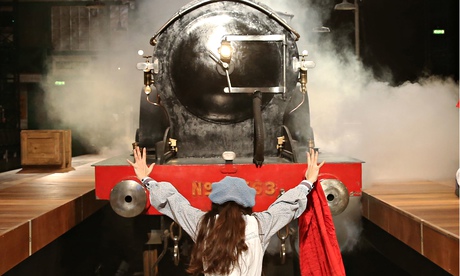
When the 60 tonnes of the William Adams Express Passenger Engine No 563 chuff on to the theatre stage in a belch of smoke, a shimmering vision of chrome, steel, slicks of engine oil, green paint and polished brass, grown men can be seen weeping.
Mike Kenny, the writer who adapted E Nesbit’s classic novel The Railway Children for the stage play, now running at the new theatre at King’s Cross station, London, freely admits he too has joined the weepers .
While commuters snarl helplessly over late-running trains a few metres away, every night, bang on time, one service pulls into a new platform there – inside a 1,000-seat pop-up theatre built on the site of Google’s planned headquarters in the railway lands.
The locomotive was built at the London and South Western Railway’s Nine Elms works in south London in 1893, and was retired only in 1948. The show was created at the National Railway Museum in York in 2008, a co-production with the York Theatre Royal that had been intended to last for a few weeks as summer holiday entertainment. Both now seem likely to run for ever.
The show is visiting London for the third time and the beautiful loco arrived ignominiously by road on a low loader. The play is scheduled to run at least until March; although previous sell-out runs at Waterloo station in 2010 and 2011, where the show won an Olivier award, were repeatedly extended.
Including the time when the loco was shipped across the Atlantic to a specially built theatre in Toronto, the show has now clocked up more than 700 performances, and raised more than £300,000 for the Railway Children charity for street children.
This summer it will return to its original home at the museum where its funds have helped build an art gallery and refurbish the main engine hall. (It has also given Kenny a very nice writing shed at the bottom of his garden.)
The large cast of actors is a little overshadowed by the shining glory of this piece of late Victorian engineering. Long before it actually appears, at the first sound of a distant steam whistle, audiences are entranced. The engine draws another glorious veteran from the 1890s, Coach No 34, one of only two complete surviving passenger carriages from the Great Northern Railway Line of Scotland.
“There just is something about this story, and about trains,” Kenny says. “I can’t count how many times I’ve seen it, each time I’m determined to hold out against it, and I’ve ended up in a puddle in my seat.” He finds this puzzling since he was never the little boy who wanted to be an engine driver. He grew up in a small town at the end of the line, at Oswestry, Shropshire.
“To me there was nothing glamorous about trains, half the town worked on the railway, and they were always just there in the background. I was a teenager when Beeching cut our line and a lot of people lost their jobs, but it meant nothing to me, I was just plotting how to get out of there and get to London.” He was also a “grumpy teenager” when the 1970 film, The Railway Children, which became far more famous than E Nesbit’s 1906 book, was released.
In 2008, Kenny, by then renowned for his work in community and children’s theatre, and living in York, was approached by the director Damien Cruden to do the adaptation; he says his instinct was to say no. But Cruden was a big fan of the film, and as early as 1997, when he was first interviewed as artistic director at the Theatre Royal, had pitched the idea of adapting it with a real steam train on stage.
It was the book and the museum that got Kenny on board. “I read it as a child, but when I read it again I was astonished. Nesbit’s so magnificent, so modern: there is nothing soft about her. You feel you’re having a conversation with her about issues that are still so current – society and families, poverty, and political refugees. Going back to the original gave me the chance to put some of that toughness back.
“And the museum itself, as I explored it with Damien Cruden looking for a space we could use, fascinated me. The people who go there are very interesting, and quite distinctive from many other museums – you can hardly even use the term working-class any longer, but many of the visitors are people who have an engagement and interest and respect for the world of work.”
He has several projects on the go, including an adaptation of Winnie the Witch, for Birmingham Rep, which has a consultant magician on call for little technicalities such as flying broomsticks and colour-changing cats.
However, he admits, ruefully, that it is probably The Railway Children that he will be remembered for. “I think the quality of goodness hooks audiences – the people in the story are good and do good things for their fellow human beings. But yeah, it’s the train. I know it really, it’s the train.”

